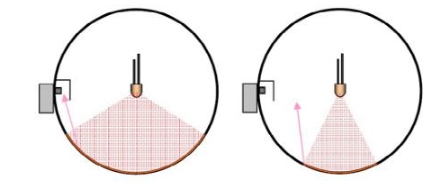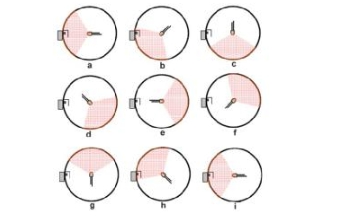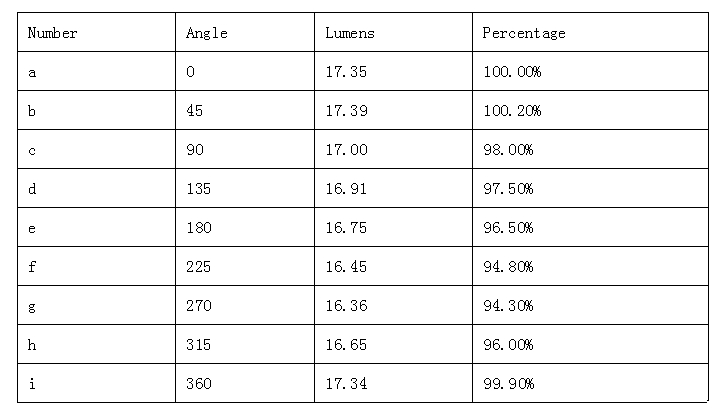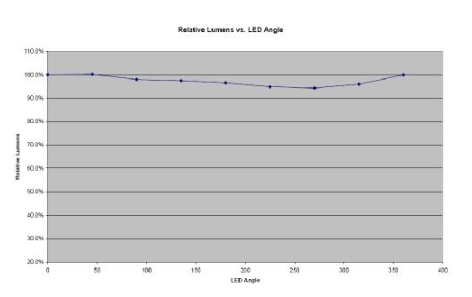“Different from traditional light sources, the luminous flux measurement of LED light sources poses a great challenge to the accuracy of the equipment in the process of using integrating spheres to measure luminous flux. On the one hand, compared with traditional light sources, LEDs are generally more directional and do not emit light uniformly throughout the space. This feature makes the direct LED light distribution on the surface of the integrating sphere non-uniform. This uneven distribution will cause the direct light from different LEDs to have different reflection characteristics of the detector. Since the position of the detector and the position of the baffle are fixed, the direct performance of the various reflection distributions is the signal fluctuation. In a common test system, there are differences in LEDs with different light-emitting angles, and the same L
“
Different from traditional light sources, the luminous flux measurement of LED light sources poses a great challenge to the accuracy of the equipment in the process of using integrating spheres to measure luminous flux. On the one hand, compared with traditional light sources, LEDs are generally more directional and do not emit light uniformly throughout the space. This feature makes the direct LED light distribution on the surface of the integrating sphere non-uniform. This uneven distribution will cause the direct light from different LEDs to have different reflection characteristics of the detector. Since the position of the detector and the position of the baffle are fixed, the direct performance of the various reflection distributions is the signal fluctuation. In a common test system, there are differences in LEDs with different emission angles, and the same LED in different placement directions has the same emission at different positions. Even if the rated luminous flux is the same; the actual measured value is different. According to the customer’s verification results, the influence of the LED placement direction of the ordinary LED test system on the luminous flux measurement results is always more than 50% (the difference between the maximum signal and the minimum signal of the same LED measured in different directions)
When measuring different light-emitting angles of different LEDs, the distribution of direct reflection has different effects on the detector due to the distribution difference of the inner surface of the integrating sphere, which directly affects the difference in measurement accuracy (as shown in Figure 1).

Figure 1: Different illumination angles have different effects on LED measurements
Improving the accuracy of LED luminous flux testing in integrating spheres
On the other hand, LED test systems usually use halogen tungsten lamps as the standard light source, and compared with LEDs, the standard lamps used are very different in appearance, illumination distribution characteristics and spectral characteristics. Therefore, the difference between the two should be corrected by the absorption coefficient.
analyze:
The internal reflection characteristic of the integrating sphere is one of the key factors that make the LED directivity affect the measurement accuracy. In common LED test systems, the reflectivity and Lambertian properties of the surface coating of the integrating sphere are not ideal. One reason is low reflectivity, another is poor diffuse reflection characteristics. The result of the low reflectivity of the surface of the integrating sphere is that the direct light of the LED gradually decays after several reflections. However, in the whole process of light mixing, both the direct illumination light and the reflected light occupy a large proportion, which is dominant. In some cases, low reflectivity materials can have a strong shadowing effect on the back of the baffle probe. However, it is the light and shadow effect of the straight line reflection that causes the measurement to be inaccurate.
In addition, lower diffuse reflectance will seriously affect the attenuation of the signal. In the process of light measurement, light is reflected multiple times in the integrating sphere, and each reflection will produce a certain attenuation, but the influence of reflectance on light intensity is strengthened after multiple reflections. For example, the reflected light is reflected at the integrating sphere 15 times, and if there is a 5% difference in reflectivity, the signal attenuation may more than double. In practice, the difference in reflectivity of the integrating sphere is much more than that.
Current LED test systems do not have standard LEDs used as standard light sources. In the measurement process, we still choose to use the standard tungsten halogen lamp as the standard light source. Since the external structure of standard lamps and measured LEDs is very different, including the light absorption effect of the LED lamp holder and the difference between the standard lamp installation position and the LED installation position, all of these are important factors affecting the accuracy of the test results.
solution:
LPCE-2 Spectrometer & Integrating Sphere LED Test System is a set of LED test system developed by Shanghai Lishan Electronics, which fully complies with the relevant requirements of LM-79 and CIE, and effectively solves various defects of traditional LED test systems.
Compared with the large-scale assembly and production technology of traditional integrating spheres, Lisun Electronics adopts one-time molding technology to produce integrating spheres, and its shape completely conforms to the spherical structure of 4π or 2π. Lisun’s integrating sphere is also coated with high reflection and diffusivity, so that the lamp is designed to be aligned with the detector position in the opening position. This improvement maintains good consistency in test results even when using highly directional LEDs or using position mode in extreme conditions.
The LPCE-2 uses a standard tungsten halogen lamp as the standard lamp combined with an optional auxiliary lamp to measure the effect of the difference between the LED lamp holder and the standard lamp holder on the test results. This standard lamp has been strictly calibrated by Lishan Electronic Calibration Laboratory; the test results can be traced back to NIM.
Aiming at the accuracy of the above LED test results, the LPCE-2 test system is used to conduct the corresponding test. The test conditions are as follows: 5 high-brightness green LEDs are used, the power is about 0.35W, and the illumination angle is about 30°. The LPCE-2 test system is used for 9 measurement positions, which represent possible LED position patterns, as shown in Figure 3.

Figure 2: Different LED Position Patterns
in conclusion:
The relationship between the measured luminous flux and the LED position pattern is shown in Figure 4 and Figure 5. As can be seen from the test results, even in the most extreme cases, when the LEDs are placed in front of and behind the opening of the detector, the peak value of the luminous flux test results is still less than 5%. This is a very good test result. In the actual test process, the repetition error of LED luminous flux measurement is far less than 0.1%. It can be seen from this that the test results of the LPCE-2 test system are reliable and stable, and can provide a reliable guarantee. This standard system not only greatly supports the development and production of LEDs, but is also an ideal choice for optical performance measurement in the LED industry.

Figure 3: Luminous flux corresponding to different LED test positions

Figure 5: Relationship between LED test position and luminous flux
Shanghai Lishan quality system has passed ISO9001:2015 strict certification. As a CIE member, LISUN products are designed based on CIE, IEC and other international or national standards. All products have passed CE certification and third-party laboratory certification.
The Links: FF150R12KS4 LQ057Q3DC12

0 Comments for “How can I improve the accuracy of LED luminous flux testing in an integrating sphere?”